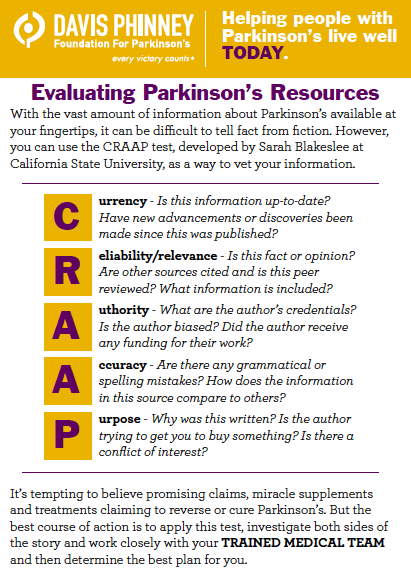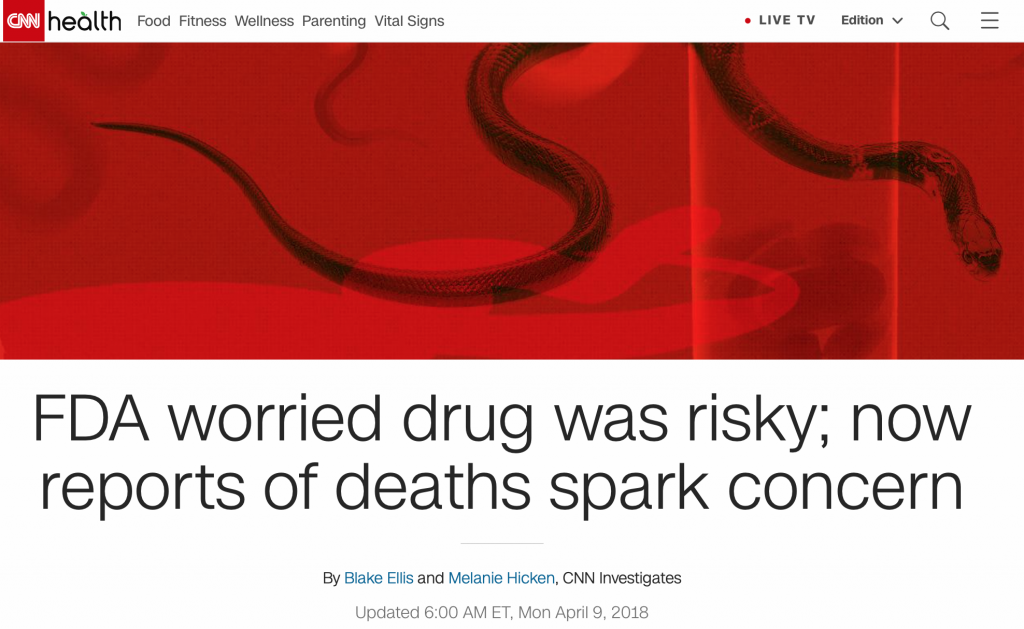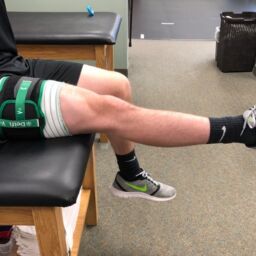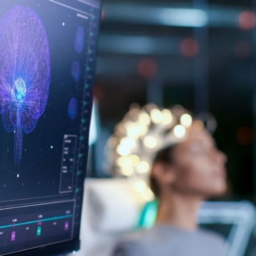The amount of information about Parkinson’s that’s available online with just a few strokes of the keyboard is astonishing; however, sifting through it is no easy task. And when you’re trying to come to terms with an often scary and surprising diagnosis, it makes doing so even more difficult.
We wish there was a quick and easy way to vet information online, but until some magic app comes our way to do the vetting for us, we’d like to share a test that will help you evaluate Parkinson’s resources to ensure you get the most accurate, updated and reliable information possible.
It’s called the CRAAP test, and it was created by Sarah Blakeslee at the California State University, Chico in 2004 and has been updated over time.
The C in CRAAP stands for currency. In a field like Parkinson’s, in which medical research is constantly being carried out and new discoveries are made regularly, it’s very important to make sure that you’re getting up-to-date information. Check the publication date on sources to ensure that the information is current.
The R in CRAAP is for reliability and relevance. When evaluating reliability and relevance, ask the following questions:
- What information is included in this source?
- Is this the opinion of one person, or is it based on facts?
- Are other legitimate sources cited?
- Has this been peer-reviewed?
- Has the author cherry-picked their data?
The two As in CRAAP represent authority and accuracy. Question the author’s credentials by ensuring that the person is an expert in their field. Look for publishers or sponsors of the material and consider whether there is a bias or conflict of interest present. Check if there are advertisements on the page because that’s usually a sign that the source is receiving private funding and could be biased. Make sure that the writing has no spelling or grammatical errors and that everything that is presented as fact is backed up by cited references. Then, take the next step and apply the CRAAP test to those sources.
The P in CRAAP stands for purpose. This involves questioning whether the source represents facts or opinions, whether there is any bias involved and whether the person writing the source is trying to get you to buy something.

Finally, and this is perhaps the trap that’s easiest to fall into, remember that just because the media is hyping something up, or it seems that the same exciting and promising headline keeps showing up in your feed every day for a month, it doesn’t mean it’s true.
 For example, you may remember the CNN story about how a drug (Nuplazid) that is used to treat Parkinson’s Disease Psychosis (PDP) was responsible for a large number of deaths. It caused a panic in the Parkinson’s community and many people emailed us to find out what we had to say about it.
For example, you may remember the CNN story about how a drug (Nuplazid) that is used to treat Parkinson’s Disease Psychosis (PDP) was responsible for a large number of deaths. It caused a panic in the Parkinson’s community and many people emailed us to find out what we had to say about it.
It’s really tough when news like that hits the cover page of CNN because many people trust that source. However, while the article wasn’t entirely false, it left out information that may have tamed the response. For example, none of the cases discussed in the article could be directly linked to Nuplazid. However, the mere mention of the link combined with very upset family members who believe Nuplazid caused their loved one’s death is very persuasive.
The original article also didn’t mention the role that prescribing doctors could have played in the statistics. While we’d like to think that all doctors have prescription practices that are beyond reproach, many do not. Many don’t do enough research on each medication to know all of the other drugs that may negatively interact with it. Many don’t give the right doses. And many don’t explain the true nature of the Black Box warning that came with the drug. All of those factors can impact how people respond to that drug, or any drug for that matter.
The story also attempted to bury the fact that the majority of people who died were in very late stages of Parkinson’s and experiencing a wide variety of problems. And that in many cases, family members decided that trying the medication was better than allowing their person with Parkinson’s to live with the debilitating and scary hallucinations and delusions that had become a normal part of their life.
(Note: The story is ongoing. If you’d like to read some of the follow-ups from CNN, read this and this. If you’d like to know what the FDA and Acadia have to say, read this and this. To find out more about clinical trials and Nuplazid, go here.)
Are we recommending we should all ignore the scary side of the story? Absolutely not. We would just like to encourage you to take a breath the next time you read something about Parkinson’s that terrifies you or that makes you think all of your symptoms will disappear overnight. Take a breath and sit with it for a moment. Then, resist the temptation to let one source guide your opinion and go deeper.
Over the years we’ve watched the media hype everything from unregulated miracle supplements to CBD to a variety of alternative treatments claiming to cure or reverse Parkinson’s. As a person with Parkinson’s or a care partner to someone living with Parkinson’s, it’s tempting to believe the hype. But the best course of action is to apply the CRAAP test, go deeper and always investigate BOTH sides of a story, work closely with your trained medical team and then determine the best path for you.
Further Learning
How the CRAAP Test Was Developed
More In-Depth Questions You Can Ask When Evaluating Sources
Beware Online “Filter Bubbles”
Why Most Published Research Findings are False
Evaluating Health Information
Factsheet: Medline Journal Selection
PubMed Tutorial
The Medical Bullshit Detector Part I: Untrustworthy Products and Unbelievable Ideas
The Medical Bullshit Detector Part II: Unreliable Experts
Want More Practical Articles Like This?
Much more can be found in our latest edition of Davis Phinney Foundation’s Every Victory Counts® manual. It’s packed with up-to-date information about everything Parkinson’s, plus an expanded worksheets and resources section to help you put what you’ve learned into action. Request your copy of the Every Victory Counts manual by clicking the button below.

















